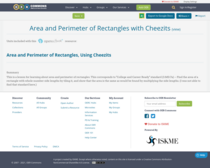Description
- Overview:
- This is a lesson for learning about area and perimeter of rectangles.
This corresponds to "College and Career Ready" standard (3.MD.7a) -- Find the area of a rectangle with whole-number side lengths by tiling it, and show that the area is the same as would be found by multiplying the side lengths.
(I was not able to find that standard here.)
- Subject:
- Mathematics
- Level:
- Middle School, High School, Adult Education
- Material Type:
- Lesson Plan
- Author:
- Susan Jones
- Date Added:
- 05/25/2016
- License:
-
Creative Commons Attribution

- Language:
- English
- Media Format:
- Graphics/Photos, Text/HTML


on Sep 16, 08:17pm Evaluation
CCSS.Math.Content.3.MD.C.7a: Strong (2)
Lesson covers tiling quite well. However, it does not pay much attention to the multiplying side lengths portion of the standard.
on Sep 16, 08:17pm Evaluation
MCCRS.Math.Content.3.MD.C.7a: Strong (2)
Lesson covers tiling quite well. However, it does not pay much attention to the multiplying side lengths portion of the standard.
on Sep 16, 08:17pm Evaluation
Quality of Explanation of the Subject Matter: Strong (2)
This lesson does a good job of showing how area and perimeter differ, and how they vary compared to each other. However, there is little connection to finding area in any other way but tiling, and does not mention any other method for finding perimeter outside of counting.
on Sep 16, 08:17pm Evaluation
Quality of Assessments: Limited (1)
There is very little mention of assessment, and no goals stated for the level of proficiency students should reach by the end of the lesson. The objectives state what will be done in the lesson, but does not state any specific goals for progress or proficiency.
on Oct 24, 11:37am Evaluation
Quality of Explanation of the Subject Matter: Strong (2)
While the explanation of the lesson is understandable, the actual delivery of the lesson had a lot more emphasis of the idea that "area measures how many squares," and why we use "square units" for area. The distinction between area and perimeter was also emphasized ("perimiter is outside; area is inside.")
on Oct 24, 11:37am Evaluation
Utility of Materials Designed to Support Teaching: Superior (3)
The use of manipulatives and graph paper to lay the squares on was very effective, as was the "translation" to the mathematical language to express area through addition and multiplication.
The Cheezits functioned as intended. Non-edible squares would be available if allergies or other issues made Cheezits impractical.
on Oct 24, 11:37am Evaluation
Quality of Assessments: Limited (1)
I added practice and assessment to the lesson but until this version is updated, the assessment value is limited.
on Oct 24, 11:37am Evaluation
Quality of Instructional and Practice Exercises: Strong (2)
Practicing with squares and graph paper and then practicing with more abstract representations was effective.
It does require lots of "repeat" practice, and then transition to paper with and without grid marks. That transition was done in the next day's lesson.
on Oct 24, 11:37am Evaluation
Opportunities for Deeper Learning: Strong (2)
This inspired students to recognize connections between concrete and abstract reasoning (adding cheezits vs. multiplying numbers).